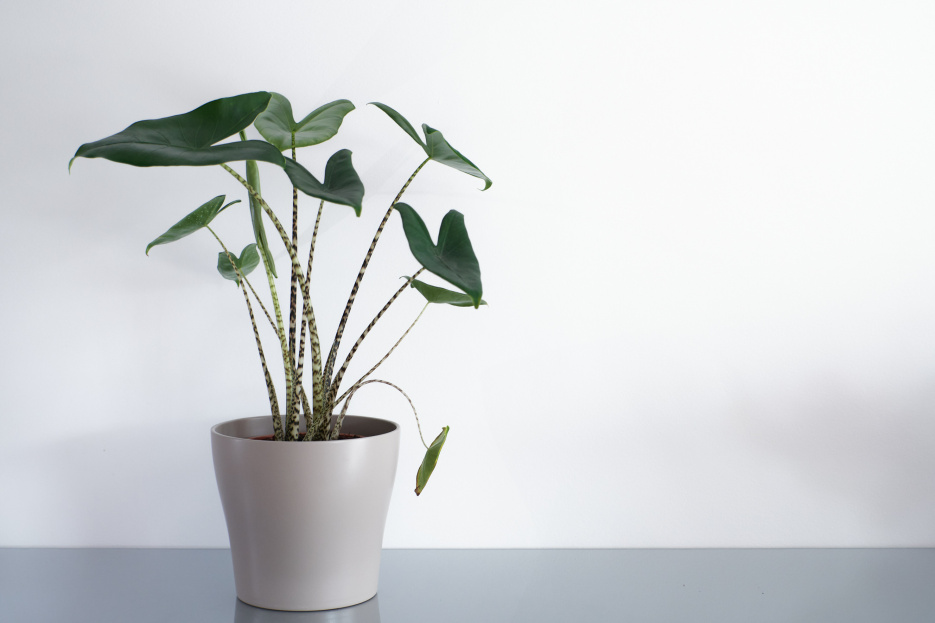
Alocasia Zebrina, also known sometimes as the Zebra Alocasia, is a striking tropical plant that boasts bold, arrow-shaped leaves with beautiful contrasting green and white veins. Its unique zebra-patterned stems further elevate its exotic appeal, making it a favorite among houseplant collectors. While Alocasia Zebrina is relatively easy to care for, it does have some specific needs to thrive. Here's a guide to ensure your Alocasia Zebrina flourishes in your home.
Alocasia Zebrina thrives in bright, indirect light. Direct sunlight can scorch their delicate leaves, leading to unsightly brown spots and wilting. For optimal growth, place your plant near an east or west facing window where it can receive ample filtered light throughout the day. While it can tolerate lower light conditions, its growth may slow down, and the vivid colors may become less pronounced. For the best results, aim for plenty of bright, indirect light to keep your plant happy and healthy.
Alocasia Zebrina enjoys consistent moisture but is sensitive to overwatering. The key to watering is allowing the soil to dry out slightly between waterings. To check if your plant needs water, simply stick your finger into the top inch of the soil. If it feels dry, it’s time to water; if it’s still moist, wait a day or two before checking again.
During the growing season (spring and summer), Alocasia Zebrina will need more frequent watering. However, in the fall and winter, its growth slows, so you can cut back on watering to avoid root rot. Be sure to use well draining soil, and ensure your pot has drainage holes to allow excess water to escape.
Alocasia Zebrina requires well-draining, loose soil that retains moisture without becoming waterlogged. A general houseplant potting mix works well, but you can improve drainage by adding ingredients like perlite or orchid bark. This will help to ensure that the roots don’t sit in water for too long, which could lead to root rot.
When repotting, choose a pot that is slightly larger than the current one to allow your plant room to grow. Always ensure your pot has proper drainage holes to allow any excess water to escape. Repot the plant every couple of years, or if you notice the roots becoming too crowded.
Being a tropical plant, Alocasia Zebrina loves warm and humid environments. The ideal temperature range for your Alocasia Zebrina is between 65°F and 80°F (18°C to 27°C). Avoid exposing it to temperatures below 50°F (10°C), as cold drafts can cause damage to its delicate leaves.
This plant also enjoys higher humidity levels, typically around 60% or higher. To meet its humidity needs, you can mist the leaves regularly, set the plant on a humidity tray filled with pebbles and water, or place it near a humidifier. In drier indoor environments, these steps will help ensure the plant maintains its lush, vibrant foliage.
Alocasia Zebrina is a moderate feeder. During the growing season (spring and summer), you can feed your Alocasia Zebrina once a month with a balanced, water-soluble fertilizer diluted to half strength. This will support healthy growth and encourage the plant’s striking foliage.
In the fall and winter, when the plant enters a dormant period, you can stop fertilizing, as the plant's growth will slow down. Be cautious not to over fertilize, as this can lead to nutrient imbalances and damage to the roots.
Alocasia Zebrina doesn’t require much pruning, but you should remove any yellow, damaged, or dead leaves to keep the plant looking tidy and encourage new growth. Simply use clean, sharp scissors or pruning shears to trim the leaves.
The large, glossy leaves can collect dust, which can hinder the plant’s ability to photosynthesize. Wipe the leaves gently with a damp cloth every few weeks to keep them clean and shiny. This will also help maintain the plant's overall health.
Alocasia Zebrina is toxic to pets, including cats and dogs. The plant contains calcium oxalate crystals, which can cause irritation to the mouth and digestive tract if ingested by pets. It’s best to keep this plant out of reach of curious pets to avoid any accidents.